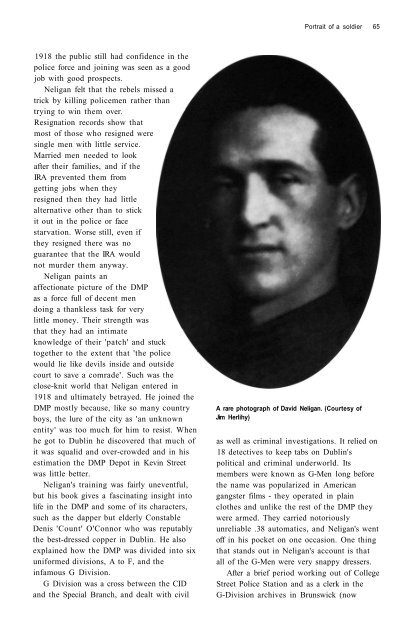You also want an ePaper? Increase the reach of your titles
YUMPU automatically turns print PDFs into web optimized ePapers that Google loves.
Portrait of a soldier 65<br />
1918 the public still had confidence in the<br />
police force and joining was seen as a good<br />
job with good prospects.<br />
Neligan felt that the rebels missed a<br />
trick by killing policemen rather than<br />
trying to win them over.<br />
Resignation records show that<br />
most of those who resigned were<br />
single men with little service.<br />
Married men needed to look<br />
after their families, and if the<br />
IRA prevented them from<br />
getting jobs when they<br />
resigned then they had little<br />
alternative other than to stick<br />
it out in the police or face<br />
starvation. Worse still, even if<br />
they resigned there was no<br />
guarantee that the IRA would<br />
not murder them anyway.<br />
Neligan paints an<br />
affectionate picture of the DMP<br />
as a force full of decent men<br />
doing a thankless task for very<br />
little money. <strong>The</strong>ir strength was<br />
that they had an intimate<br />
knowledge of their 'patch' and stuck<br />
together to the extent that 'the police<br />
would lie like devils inside and outside<br />
court to save a comrade'. Such was the<br />
close-knit world that Neligan entered in<br />
1918 and ultimately betrayed. He joined the<br />
DMP mostly because, like so many country<br />
boys, the lure of the city as 'an unknown<br />
entity' was too much for him to resist. When<br />
he got to Dublin he discovered that much of<br />
it was squalid and over-crowded and in his<br />
estimation the DMP Depot in Kevin Street<br />
was little better.<br />
Neligan's training was fairly uneventful,<br />
but his book gives a fascinating insight into<br />
life in the DMP and some of its characters,<br />
such as the dapper but elderly Constable<br />
Denis 'Count' O'Connor who was reputably<br />
the best-dressed copper in Dublin. He also<br />
explained how the DMP was divided into six<br />
uniformed divisions, A to F, and the<br />
infamous G Division.<br />
G Division was a cross between the CID<br />
and the Special Branch, and dealt with civil<br />
A rare photograph of David Neligan. (Courtesy of<br />
Jim Herlihy)<br />
as well as criminal investigations. It relied on<br />
18 detectives to keep tabs on Dublin's<br />
political and criminal underworld. Its<br />
members were known as G-Men long before<br />
the name was popularized in American<br />
gangster films - they operated in plain<br />
clothes and unlike the rest of the DMP they<br />
were armed. <strong>The</strong>y carried notoriously<br />
unreliable .38 automatics, and Neligan's went<br />
off in his pocket on one occasion. One thing<br />
that stands out in Neligan's account is that<br />
all of the G-Men were very snappy dressers.<br />
After a brief period working out of College<br />
Street Police Station and as a clerk in the<br />
G-Division archives in Brunswick (now



